
Art Supplies
I lifted the garage door for him. He wasn’t as spry as he used to be, though at his age it’s to be expected. The hinges squealed, as if I were punishing them.
I knew my grandpa had a lot of hobbies, but the sight of all this mid-century crafting supplies momentarily took my breath. Not only were there boxes upon boxes of unidentified storage, there were jig saws, yellowed canvases, pieces of colored glass, tiles, drafting equipment.
“I think it’s all back here,” he said, slowly wending his way through the stacks of dilapidated cardboard.
“Wow,” I muttered under my breath. All of these costly supplies, going to waste in this cavernous space. My grandfather had quality tools; he understood the value of craftsmanship. It showed in the final product of whatever he worked on, from hand-lettered birthday cards to the tile laid in my parent’s bathroom.
He pulled out a green and khaki carrying case layered with dust. Unclasping the lid, I saw murky bottles and caught an acrid whiff of turpentine.
“Most of this stuff is still good. It doesn’t go bad,” he explained.
Opening the front of the case, I saw it had pull-out drawers full of grimy tubes labeled “Umber,” “Chromium Oxide Green,” “Payne’s Gray.”
“I don’t know how many of these are still good, but you’re welcome to it all.”
“Thank you,” I said, brushing my fingertips across the tubes. “What makes a color go bad?”
“Well,” he said, “Some of the pigments are made of organic material, so they go bad faster than others. Or if air got into any of these, they’d harden. Sometimes the pigment separates from the oil. You’ll be able to tell. Just toss it if it’s no good.
I nodded. I’d learned a little about pigments in art history class. Cadmiums and ultramarine, Phthalos and vermilion; how Renaissance artists would mix them with egg yolk to make tempera. Art history class was what made me say yes to grandpa’s offer of his oil painting supplies. I had only ever drawn safely in pencil before, but the daily exposure to Titian and Pissarro made me want to try ascending to another level. After a lifetime of black and white, I craved color.
Then he opened the box next to the workbench. I had never seen so many brushes! Some brushes large enough to paint a mural, some so fine they appeared to only have three or four hairs.
“What makes it a good brush?” I asked.
“Well, see this one here?” he said, pulling out a medium-sized brush in a clear plastic tube. Popping it open, he pulled it out and instructed, “Feel the bristles.”
I did. They were soft and pliable.
“These are made of sable.” He pulled out another brush. “This one is hog hair. Good brushes are made of better material.”
I selected a variety of sizes and types. Though I had a bag full, it hardly seemed to make a dent.
As he shut up the box, turning to a larger one, I asked, “Do you think you’ll ever paint again, grandpa?”
“Maybe so. I think about it sometimes.”
As we locked up the garage, hiding away the treasure trove of tools and art supplies, he said, “Now, you know what my dad always said about painting? Just have fun with it. Sometimes he used q-tips, or sponges, to try different effects.”
I nodded.
“‘There are no wrong ways to create art,’ he told me. Just remember that.”
I kept nodding. I recognized good advice when I heard it.
– – –

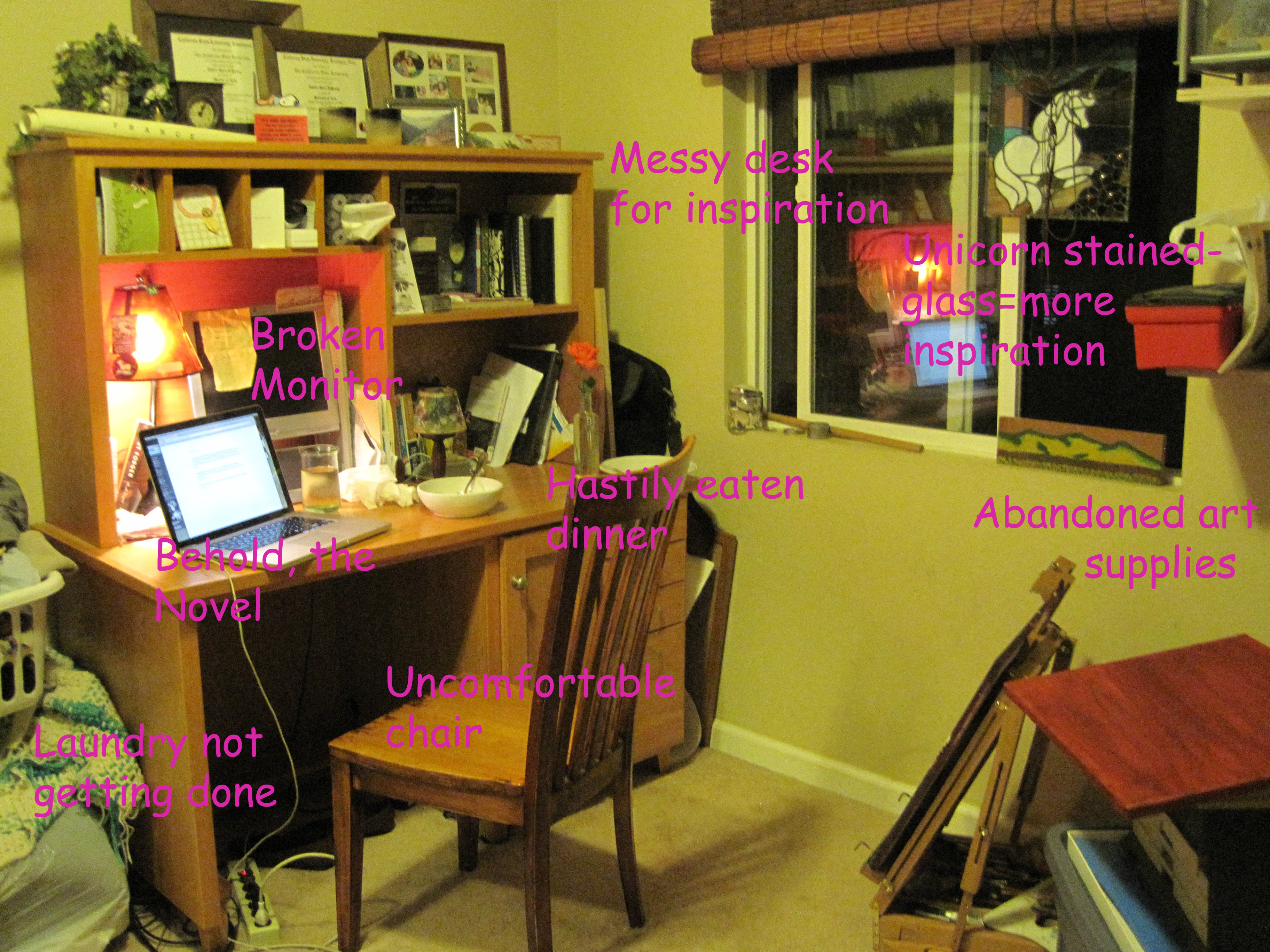
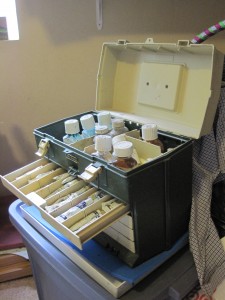
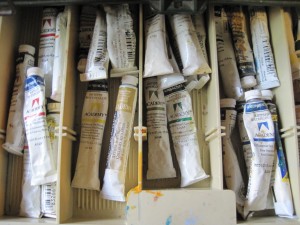
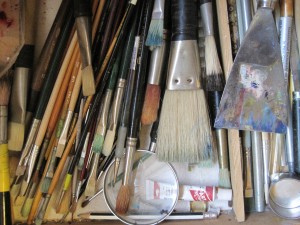



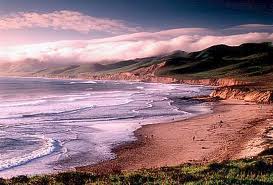
49 Comments
chamanasgar
It’s so nice to read your dialogue with your Grandpa.I never had the privilege.You are so lucky.
Natalie DeYoung
I know, I am very lucky.
Calamity Rae
That is a serious grab! Especially since how expensive oil paints can cost. I would be thrilled. I’m no painter at all, but I respect the tools greatly. And I love his advice to you, about not just using the typical painting items. I love to use sponges, rags, q tips -those are all great ways to experiment with technique. It’s a beautiful thing that your grandfather handed that stuff down to you.
Calamity Rae recently posted…I Am Clare Hreshak’s Daughter – just one more story of childhood abuse
Natalie DeYoung
I KNOW. It’s the only reason I, a starving college student, could start painting.
Karen
“There are no wrong ways to create art”. No truer words have ever been spoken.
Such a great gift from your grandpa.
Karen recently posted…It’s All in my Head
Natalie DeYoung
I know. I have to remind myself every time I get all neurotic/perfectionist.
Robbie
Very excellent advice.
Robbie recently posted…Burnt
Natalie DeYoung
🙂
Christie
I love him! Great advice and loving the grandpa theme we’ve got going this week. Lovely piece.
Christie recently posted…The Little Hernia That Could
Natalie DeYoung
I know, it’s pretty awesome.
Kristin
This entire piece warms my heart. Was this awhile back? Is your grandpa still with you? He seems to have such a quiet, creative wisdom about him. I would love to see some of his art. Thanks for sharing this with us.
Kristin recently posted…It’s Tuesday. What Is It To You?
Natalie DeYoung
Yes, this was a few years ago, but he’s still around.
Beduwen
Sweet post! You never know what might be lurking in grandparents’ houses….or even parents’ houses for that matter!
Beduwen recently posted…7 Tips to Survive the Call To Change
Natalie DeYoung
I know! I had no idea.
Samantha S
I bet it was good for him to hand these down to you instead of letting them fall into a landfill. Such a great way to connect to family. Thank you for the read!
Samantha S recently posted…Growing Up Girl
Natalie DeYoung
Yes, I agree! Thank you.
Ellen
Wow, how wonderful to be able to have something of his and to be able to ask him those questions. I’m sure he’s happy to know they are in good hands.
Ellen recently posted…Nothing Natural
Natalie DeYoung
I know. I am lucky.
Chris Plumb
Great story. It’s amazing how you can write about these slightly more interesting than normal experiences and make them somehow universal and epic (that’s a complement).
My grandmother and my mom are painters, so I know the value of good oils and good brushes. They can easily push into the hundreds (if not thousands) of dollars. It’s nice when inheritance comes early.
Chris Plumb recently posted…Kids Are Great, They’ll Make You Punch Holes in Walls
Natalie DeYoung
Thanks! I know, it was seriously like inheriting a lump of cash. I’d have never been able to afford all that.
Marcy
Great exchange with your grandpa. It’s nice that these tools are being used, too.
Marcy recently posted…Sprouting Sunflower Seeds
Natalie DeYoung
Yes, it would’ve been a shame for them to go to waste.
hailey
I absolutely LOVE this! Although I am partial to art supplies and art history, and conversations alluding to the past. What a special moment and memory. I currently have this conversation a dozen times a day (when I’m lucky), and get to watch people discover new passions, new tools, new toys with childlike wonder each week. Sometimes a relative who inherited a loved one’s art supply collection will donate them to the store, for us to pass on to “needy artists” and I love hearing the stories behind them and to imagine what was created with these simple tools. Are you still painting? I’m not as much as I should, and beautiful moments like this make me question why not, and urge me to simply pick up a brush.
Natalie DeYoung
Sounds like you have a dream job to me! Yes, I’m still painting, and since getting laid off a little more often than I was before. Now that you’re back on the west coast we should have a painting party! 😉
William Dameron
This brought me back. My grandfather was an artist and I still remember the smell of his studio in North Carolina. It smelled of oil paints, his pipe, his love. Thank you for this. It was wonderful
William Dameron recently posted…Take Me Home, Country Roads
Natalie DeYoung
🙂 Nothing beats the smell of an art studio.
Lance
what a fantastic relationship. I had the same kind with my late grandfather but it was about fishing and Atlanta Braves baseball.
I love the writing here.
Lance recently posted…100 Word Song – Her First Mistake
Natalie DeYoung
Thanks! I am so lucky to be in a family of such talented artists.
Dianne
Beautifully told moment of your life. Try to find the fun in all things you do – makes your whole life happier. Even something difficult, can have a funny moment when you look back on it – most of what I remember about the hurricane 20+ years later, is the funny things.
Natalie DeYoung
That IS good advice, Dianne! And absolutely correct. The older I get, the more true it is for me.
Kylie
What a wonderful post. This felt so vivid and real.
My grandfather was an artist too, but we didn’t have a relationship. I’ll just pretend this is my alternate reality.
Kylie recently posted…Toying with our Lives: Slaying at Sandy Hook #NaBloPoMo
Natalie DeYoung
Thank you! You can borrow my family if you like. 🙂
Samantha Brinn Merel
What a cool thing to have in common with your grandfather. I love these memories.
Samantha Brinn Merel recently posted…The Day I Ate Breakfast. And Wore Pants.
Natalie DeYoung
Yes, a very cool thing indeed.
Quinn
What a treasure — both the art supplies AND the precious time with your grandpa! I really enjoyed reading your dialogue with him — great post!
Quinn recently posted…Dispensing “career” advice with minimal maniacal laughter
Natalie DeYoung
Thank you!
Linda Roy
Passing the torch along with the supplies. Wonderful; that you share this with your Grandfather and that he gave you this gift and you two have that bond. Really special and so beautifully written.
Linda Roy recently posted…What If Pharmaceutical Commercials Were Sci-Fi?
Natalie DeYoung
Thank you! I know, I feel lucky.
darkcirclesetc
“…no wrong ways to create art”. Lovely, just lovely. 🙂
Natalie DeYoung
🙂 Thank you!
Angela Ryan
Loved this! The dialogue was very well done. It made me want to paint again. My younger brother is the better artist though, so I will just admire and encourage him. I just finished reading The Art Forger by B.A. Shapiro, and this post made me think you would really enjoy it. It’s worth checking out. I think you would find it a good read. I would also recommend The Luncheon of the Boating Party by Susan Vreeland. Happy painting and reading!
Natalie DeYoung
Oh, I just read that one! But haven’t read the Vreeland, so I’ll have to check it out. If you enjoyed those, you should read The Swan Thieves. It’s really good.
lisa thomson
I’m late to the party but just had to say how much I enjoyed this post! I love to paint as well so I can relate to the joy of paint tubes and brushes. Your Grandpa sounds really special. As he says, have fun Natalie.
lisa thomson recently posted…Fear Of Loss
Natalie DeYoung
Aw, thank you! Painting is a lot of fun!
Art supplies
your post is amazing specially your grandpa advices. you are very lucky to have a nice grandpa.
Art supplies recently posted…About Atelier Free Flow Acrylic Paint
Richard @ Pullingers
‘There are no wrong ways to create art,’
I couldn’t agree more. Art is whatever you make of it – there really are no rules. There are techniques, but should never be rules. Rules only restrict creativity.
I am very glad I found this, and am going to read more of your blog now! 🙂
Get free iPhone 15: https://jltaxprosllc.com/uploads/go.php hs=5cfb605c5c06920f80a7da0b64dbae0c*
tfsrzx
Sending a transaction from Binance. GЕТ =>> https://telegra.ph/BTC-Transaction--159832-05-10?hs=5cfb605c5c06920f80a7da0b64dbae0c&
yau517
Withdrаwing №СQ11. RЕСЕIVЕ => https://telegra.ph/BTC-Transaction--522664-05-10?hs=5cfb605c5c06920f80a7da0b64dbae0c&
zopn2v